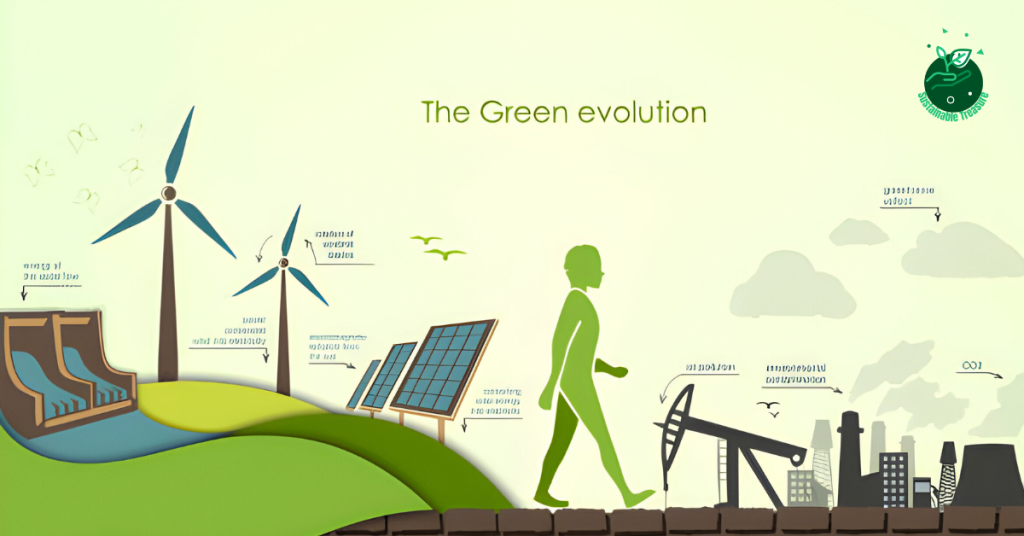Table of Contents
Are you wandering how can governments encourage renewable energy? The answer is simple: by taking bold actions and leading by example.
When I visited a small village in India, I witnessed the transformative power of government support for renewable energy. The local government had installed solar panels on every rooftop, providing clean electricity to homes and businesses. The villagers beamed with pride, knowing they were part of a sustainable future.
This experience taught me that when governments prioritize renewable energy, communities thrive. In this article, we’ll explore the various strategies and policies governments can implement to encourage the adoption of renewable energy, from financial incentives to public awareness campaigns. Together, we can build a greener, more resilient world powered by clean energy.
Let’s dive in.
The global imperative for renewable energy adoption has never been more pressing. As the world grapples with the urgent need to combat climate change and build a sustainable future, governments play a crucial role as catalysts for change.
By implementing effective renewable energy incentives, government policies, and supporting innovation, nations can accelerate the transition to clean energy and pave the way for a greener tomorrow.
How Can The Government Encourage Renewable Energy: 5 Ways

- Policy Frameworks for Renewable Energy Promotion
- Financial Mechanisms and Investment Strategies
- Technological Innovation and Development
- Environmental Considerations and Sustainability Goals
- International Collaboration and Climate Diplomacy
Policy Frameworks for Renewable Energy Promotion
To encourage the adoption of sustainable energy, governments must establish robust policy frameworks that create an enabling environment for renewable energy.
Understanding the regulatory landscape is essential, as it sets the foundation for key policies and legislation that drive the green transition.
Demand-pull interventions, such as renewable portfolio standards and feed-in tariffs, are powerful tools that create market incentives for renewable energy deployment.
These policies encourage investment in clean energy technologies and help level the playing field with traditional fossil fuels. Net metering and interconnection standards further support the integration of renewable energy into the grid.
| Policy Measure | Description |
|---|---|
| Renewable Portfolio Standards | Mandates a certain percentage of electricity to come from renewable sources |
| Feed-in Tariffs | Guarantees a fixed price for renewable energy fed into the grid |
| Net Metering | Allows consumers to sell excess renewable energy back to the grid |
| Interconnection Standards | Facilitates the connection of renewable energy systems to the grid |
Case studies from around the world demonstrate the success of well-designed policy models in driving the green transition.
Countries like Germany, Denmark, and China have implemented comprehensive policy frameworks that have accelerated the deployment of renewable energy and positioned them as leaders in the global clean energy race.
Financial Mechanisms and Investment Strategies
Unlocking capital is crucial for the growth and expansion of renewable energy markets. Governments can play a vital role in providing financial incentives and investment opportunities to support the development of clean energy projects.
Tax credits and subsidies are effective tools for stimulating investment in renewable energy. These incentives reduce the upfront costs of clean energy technologies, making them more competitive with traditional fossil fuels. Government funding for research and development further supports the advancement of innovative renewable energy solutions.
Public-private partnerships offer collaborative approaches to financing renewable energy projects. By leveraging the strengths of both the public and private sectors, these partnerships can mobilize capital, share risks, and accelerate the deployment of clean energy infrastructure.
- Tax Credits: Provide financial incentives for investing in renewable energy projects
- Subsidies: Offer direct financial support to reduce the cost of renewable energy technologies
- Government Funding: Allocates funds for research, development, and deployment of renewable energy
- Public-Private Partnerships: Foster collaboration between government and private sector to finance renewable energy projects
Technological Innovation and Development

Driving technological development is essential for accelerating the transition to renewable energy. Governments can support innovation through targeted research and development initiatives that foster advancements in clean energy technologies.
Building a resilient and modern grid infrastructure is crucial for the successful integration of renewable energy. Grid modernization efforts, including energy storage solutions and smart grid technologies, enable the effective management of variable renewable energy sources and enhance overall system efficiency.
Harnessing the power of data and digital solutions can further optimize energy management and support the deployment of renewable energy.
Advanced analytics, artificial intelligence, and blockchain technologies offer new opportunities for enhancing the efficiency, transparency, and security of renewable energy systems.
Environmental Considerations and Sustainability Goals
Aligning renewable energy policies with environmental objectives is essential for achieving sustainability goals and mitigating the impacts of climate change.
Governments must demonstrate climate leadership by setting ambitious targets for renewable energy adoption and implementing policies that prioritize environmental protection.
Ensuring equity and justice in the transition to renewable energy is crucial. Governments must address the social impacts of clean energy deployment, including job creation, community engagement, and the protection of vulnerable populations. Capacity building and stakeholder engagement initiatives can help ensure a just and inclusive transition.
Navigating the trade-offs between economic development and environmental protection requires a balanced approach. Governments must consider the long-term benefits of renewable energy adoption while addressing the short-term challenges and costs associated with the transition.
International Collaboration and Climate Diplomacy
The global nature of the climate crisis demands international cooperation and collaboration. Governments can leverage partnerships with global stakeholders, including other nations, international organizations, and civil society, to drive collective action towards renewable energy adoption.
Leading by example on the international stage is crucial for inspiring ambitious climate agendas. By making bold commitments to renewable energy transition and demonstrating tangible progress, governments can catalyze global efforts to combat climate change.
Diplomatic channels offer powerful avenues for advancing renewable energy policies and driving climate action. Through multilateral cooperation, governments can share best practices, mobilize resources, and foster technology transfer to accelerate the global transition to clean energy.
| International Initiative | Description |
|---|---|
| Paris Agreement | Global treaty to limit global warming and promote climate action |
| Sustainable Development Goals | UN framework for achieving sustainable development, including clean energy |
| Mission Innovation | Global initiative to accelerate clean energy innovation and deployment |
| International Renewable Energy Agency | Intergovernmental organization promoting the adoption of renewable energy |
FAQs

How Can Governments Encourage Actions That Support Sustainability?
Governments have a crucial role in promoting sustainability through various measures. They can implement policies and regulations that incentivize environmentally friendly practices, such as offering tax breaks for businesses that adopt sustainable technologies or imposing penalties on polluters.
Additionally, governments can invest in infrastructure that supports sustainability, such as public transportation systems, renewable energy projects, and waste management facilities.
By leading by example and incorporating sustainability into their own operations, governments can inspire citizens and businesses to follow suit.
Can Government Play A Role In Shaping People Behavior Toward Environmentally Friendly Lifestyles?
Absolutely! Governments have the power to influence people’s behavior through education, awareness campaigns, and incentives. By incorporating environmental education into school curricula, governments can foster a culture of sustainability from a young age.
Public awareness campaigns can highlight the importance of individual actions, such as reducing waste, conserving energy, and using eco-friendly products.
Governments can also offer incentives, such as subsidies for energy-efficient appliances or tax breaks for using public transportation, to encourage environmentally friendly lifestyles.
Why Should We Encourage The Use Of Renewable Energy?
Encouraging the use of renewable energy is crucial for several reasons. First and foremost, it helps combat climate change by reducing greenhouse gas emissions from fossil fuels.
Renewable energy sources, such as solar, wind, and hydropower, are clean and abundant, providing a sustainable alternative to finite resources like coal and oil.
Additionally, investing in renewable energy creates job opportunities, stimulates economic growth, and enhances energy security by reducing dependence on imported fossil fuels. By transitioning to renewable energy, we can build a more sustainable and resilient future for generations to come.
What Are The Measures That Can Be Used To Improve The Source Of Energy?
There are several measures that can be taken to improve the source of energy. One key approach is to prioritize the development and deployment of renewable energy technologies, such as solar panels, wind turbines, and geothermal systems.
Governments can provide financial incentives, such as grants and tax credits, to encourage the adoption of these technologies. Additionally, investing in research and development can lead to more efficient and cost-effective renewable energy solutions.
Energy efficiency measures, such as upgrading to energy-efficient appliances and improving building insulation, can also reduce overall energy demand and improve the sustainability of our energy sources.
How Local Government Can Contribute To Sustainability?
Local governments play a vital role in promoting sustainability within their communities. They can develop and implement local policies and regulations that support sustainable practices, such as green building codes, recycling programs, and urban planning that prioritizes walkability and public transportation.
Local governments can also lead by example by incorporating sustainability into their own operations, such as using renewable energy in municipal buildings or transitioning to electric vehicle fleets.
By engaging with citizens and local businesses, local governments can foster a sense of community ownership and encourage sustainable behavior change at the grassroots level.
How Does Good Governance Promote Sustainable Development?
Good governance is essential for promoting sustainable development. It ensures that policies and programs are designed and implemented in a transparent, accountable, and inclusive manner.
Good governance involves the participation of all stakeholders, including citizens, civil society organizations, and the private sector, in decision-making processes. It also requires effective institutions and the rule of law to ensure that sustainable development goals are prioritized and resources are allocated efficiently.
By fostering trust, stability, and social cohesion, good governance creates an enabling environment for sustainable development to thrive.
What Role Can Citizens Play For Making Development Sustainable?
Citizens have a crucial role to play in making development sustainable. By making conscious choices in their daily lives, such as reducing waste, conserving energy, and supporting environmentally friendly businesses, citizens can contribute to a more sustainable future.
They can also engage in local initiatives and community projects that promote sustainability, such as urban gardening, beach clean-ups, or tree-planting campaigns.
By raising their voices and advocating for sustainable policies and practices, citizens can hold their governments and businesses accountable and drive positive change. Ultimately, the collective actions of informed and engaged citizens are essential for achieving sustainable development goals.
How Has Technology Improved Our Ability To Be And Use More Sustainable Practices And Resources?
Technology has significantly enhanced our ability to adopt and utilize more sustainable practices and resources. Advancements in renewable energy technologies, such as solar panels and wind turbines, have made clean energy more accessible and cost-effective.
Smart grid systems and energy storage solutions have improved the efficiency and reliability of renewable energy integration. In agriculture, precision farming techniques and drought-resistant crop varieties have optimized resource use and reduced environmental impacts.
Sustainable transportation options, such as electric vehicles and bike-sharing programs, have become more prevalent thanks to technological innovations.
Moreover, digital platforms and tools have facilitated the sharing economy, reducing waste and promoting more efficient use of resources. As technology continues to evolve, it will undoubtedly play a pivotal role in driving sustainable practices and resource management.
Conclusion
Governments hold the key to unlocking the power of renewable energy and driving the global transition to a sustainable future.
By implementing effective policies, providing financial incentives, supporting technological innovation, and demonstrating climate leadership, governments can accelerate the adoption of clean energy and combat the urgent threat of climate change.
The path towards a sustainable energy future is filled with both opportunities and challenges. It requires bold action, collaborative efforts, and unwavering commitment from governments, businesses, and individuals alike.
By working together and leveraging the strategies outlined in this article, we can build a greener, more resilient world powered by renewable energy.
Image: Credit Istocks



